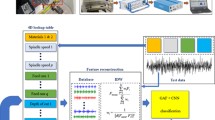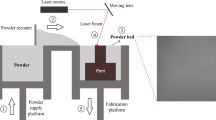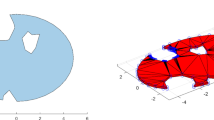Abstract
Skin parts are widely used in the modern aerospace industry. The remaining wall thickness of pockets on a skin part must be precisely controlled to reduce overall weight and ensure strength. The in-process dimensional accuracy forecast of remaining wall thickness is urgently required for process efficiency improvement and compensation. In this paper, the spindle power signal of pocket milling is used for the in-process dimensional accuracy forecast. Based on deep learning mothed, the correlation between dimensional accuracy and features extracted from power signal is established. To improve the applicability of the forecast model, a deep transfer learning model based on pockets clustering and feature reconstruction is proposed. The pockets of a skin part are divided into different types through clustering. Then, the trained deep learning network for feature extraction of one type of pocket is transferred to a new type by feature reconstruction. The results indicate that the deep transfer learning model can achieve in-process dimensional accuracy forecast for remaining wall thickness with high precision.















Similar content being viewed by others
Data availability
Not applicable.
References
Wang XZ, Bi QZ, Zhu LM, Ding H (2018) Improved forecasting compensatory control to guarantee the remaining wall thickness for pocket milling of a large thin-walled part. Int J Adv Manuf Technol 94:1677–1688. https://doi.org/10.1007/s00170-016-9785-8
Chen ZY, Wang LP, Zhang JB, Guo GQ, Fu SL, Wang C, Li XK (2020) Framework and development of data-driven physics based model with application in dimensional accuracy prediction in pocket milling. Chinese J Aeronaut 34(6):162–177. https://doi.org/10.1016/j.cja.2020.09.011
Kline WA, Devor RE, Shareef IA (1982) The prediction of surface accuracy in end milling. J Eng Ind Trans ASME 104(3):272–278. https://doi.org/10.1115/1.3185830
Sutherland JW, Devor RE (1986) An improved method for cutting force and surface error prediction in flexible end milling systems. J Eng Ind Trans ASME 108(4):269–279. https://doi.org/10.1115/1.3187077
Tsai JS, Liao CL (1999) Finite-element modeling of static surface errors in the peripheral milling of thin-walled workpieces. J Mater Process Tech 94(2–3):235–246. https://doi.org/10.1016/S0924-0136(99)00109-0
Wan M, Zhang WH, Qiu KP, Gao T, Yang YH (2005) Numerical prediction of static form errors in peripheral milling of thin-walled workpieces with irregular meshes. J Manuf Sci E T ASME 127(1):13–22. https://doi.org/10.1115/1.1828055
Kang YG, Wang ZQ (2013) Two efficient iterative algorithms for error prediction in peripheral milling of thin-walled workpieces considering the in-cutting chip. Int J Mach Tool Manu 73(73):55–61. https://doi.org/10.1016/j.ijmachtools.2013.06.001
Ratchev S, Liu SL, Wei H, Becker AA (2007) Machining simulation and system integration combining FE analysis and cutting mechanics modelling. Int J Adv Manuf Tech 35(1–2):55. https://doi.org/10.1007/s00170-006-0700-6
Wan M, Zhang WH (2006) Efficient algorithms for calculations of static form errors in peripheral milling. J Mater Process Tech 171(1):156–165. https://doi.org/10.1016/j.jmatprotec.2005.07.001
Wang L, Si H (2018) Machining deformation prediction of thin-walled workpieces in five-axis flank milling. Int J Adv Manuf Tech 97:4179–4193. https://doi.org/10.1007/s00170-018-2248-7
Li ZL, Tuysuz O, Zhu LM, Altintas Y (2018) Surface form error prediction in five-axis flank milling of thin-walled parts. J Mach Tool Manu 2018:S0890695518300300. https://doi.org/10.1016/j.ijmachtools.2018.01.005
Li WT, Wang LP, Ge SY (2021) Force-induced deformation prediction and flexible error compensation strategy in flank milling of thin-walled parts. J Mater Process Tech 297:117258. https://doi.org/10.1016/j.jmatprotec.2021.117258
Si H, Wang LP (2018) Error compensation in the five-axis flank milling of thin-walled workpieces. P I Mech Eng B-J Eng 233(2):095440541878016. https://doi.org/10.1177/0954405418780163
Gao YY, Ma JW, Jia ZY, Wang FJ, Si LK, Song DN (2016) Tool path planning and machining deformation compensation in high-speed milling for difficult-to-machine material thin-walled parts with curved surface. Int J Adv Manuf Tech 84(9–12):1757–1767. https://doi.org/10.1007/s00170-015-7825-4
Wang MH, Sun Y (2014) Error prediction and compensation based on interference-free tool paths in blade milling. Int J Adv Manuf Tech 71(5–8):1309–1318. https://doi.org/10.1007/s00170-013-5535-3
Li SM (2020) Research on error compensation method of on-machine measurement system in five axis CNC machine tool. Dissertation, Tsinghua University
Bi QZ, Wang XZ, Wu Q, Zhu LM, Ding H (2018) Fv-SVM-based wall-thickness error decomposition for adaptive machining of large skin parts. IEEE T Ind Inform 15(4):2426–2434. https://doi.org/10.1109/TII.2018.2879500
Wang JJ, Ma YL, Zhang LB, Gao RX, Wu DZ (2018) Deep learning for smart manufacturing: Methods and applications. J Manuf Syst 48(pt.C):144–156. https://doi.org/10.1016/j.jmsy.2018.01.003
Lu C, Wang ZY, Qin WL, Ma J (2017) Fault diagnosis of rotary machinery components using a stacked denoising autoencoder-based health state identification. Signal Process 130:377–388. https://doi.org/10.1016/j.sigpro.2016.07.028
Sun WJ, Shao SY, Zhao R, Yan RQ, Zhang XW, Chen XF (2016) A sparse auto-encoder-based deep neural network approach for induction motor faults classification. Measurement 89:171–178. https://doi.org/10.1016/j.measurement.2016.04.007
Shao HD, Jiang HK, Wang F, Zhao HW (2017) An enhancement deep feature fusion method for rotating machinery fault diagnosis. Knowl-Based Syst 119:200–220. https://doi.org/10.1016/j.knosys.2016.12.012
Chen YX, Jin Y, Jiri G (2018) Predicting tool wear with multi-sensor data using deep belief networks. Int J Adv Manuf Technol 99:1917–1926. https://doi.org/10.1007/s00170-018-2571-z
Yin JT, Zhao WT (2016) Fault diagnosis network design for vehicle on-board equipments of high-speed railway: a deep learning approach. Eng Appl Artif Intel 56:250–259. https://doi.org/10.1016/j.engappai.2016.10.002
Liang MX, Cao P, Tang J (2021) Rolling bearing fault diagnosis based on feature fusion with parallel convolutional neural network. Int J Adv Manuf Technol 112:819–831. https://doi.org/10.1007/s00170-020-06401-8
Shao SY, Yan RQ, Lu YD, Wang P, Gao RX (2020) DCNN-based multi-signal induction motor fault diagnosis. IEEE T Instrum Meas 69(6):2658–2669. https://doi.org/10.1109/TIM.2019.2925247
Zhao R, Yan RQ, Wang JJ, Mao KZ (2017) Learning to monitor machine health with convolutional bi-directional LSTM networks. Sensors 17(2):273. https://doi.org/10.3390/s17020273
Zhao ZW, Li YG, Liu CQ, Gao J (2020) On-line part deformation prediction based on deep learning. J Intell Manuf 31:561–574. https://doi.org/10.1007/s10845-019-01465-0
Luan XN, Zhang S, Li G (2018) Modified power prediction model based on infinitesimal cutting force during face milling process. Int J Pr Eng Man-GT 5:71–80. https://doi.org/10.1007/s40684-018-0008-7
Pan YN, Kang RK, Dong ZG, Du WH, Yin S, Bao Y (2020) On-line prediction of ultrasonic elliptical vibration cutting surface roughness of tungsten heavy alloy based on deep learning. J Intell Manuf. https://doi.org/10.1007/s10845-020-01669-9
Wen L, Gao L, Li XY (2019) A new deep transfer learning based on sparse auto-encoder for fault diagnosis. IEEE T Syst Man Cy-S 49(1):136–144. https://doi.org/10.1109/TSMC.2017.2754287
Zhao K, Jiang HK, Wu ZH, Lu TF (2020) A novel transfer learning fault diagnosis method based on Manifold Embedded Distribution Alignment with a little labeled data. J Intell Manuf 2:1–15. https://doi.org/10.1007/s10845-020-01657-z
Wang JC, Zou B, Liu MF, Li YS, Ding HJ, Xue K (2021) Milling force prediction model based on transfer learning and neural network. J Intell Manuf 32:947–956. https://doi.org/10.1007/s10845-020-01595-w
Sun C, Ma M, Zhao ZB, Tian SH, Yan RQ, Chen XF (2019) Deep transfer learning based on sparse autoencoder for remaining useful life prediction of tool in manufacturing. IEEE T Ind Inform 15(4):2416–2425. https://doi.org/10.1109/TII.2018.2881543
Luo WC, Hu TL, Ye YX, Zhang CR, Wei YL (2020) A hybrid predictive maintenance approach for CNC machine tool driven by Digital Twin. Robot Cim-Int Manuf 65:101974. https://doi.org/10.1016/j.rcim.2020.101974
Funding
The research is supported by the State Key Lab of Tribology, Tsinghua University, China (SKLT2021D16), and the National Natural Science Foundation of China (51975319).
Author information
Authors and Affiliations
Contributions
Contributions: Authors 1 and 2 developed the algorithm, performed experiments, and drafted the manuscript. Authors 4 and 5 developed the data acquisition system used in experiments and contributed to the analysis of the results. Authors 3, 6, and 7 contributed to the writing and editing of the manuscript.
Corresponding author
Ethics declarations
Ethics approval
Not applicable.
Consent to participate
Not applicable.
Consent for publication
Not applicable.
Competing interests
The authors declare no competing interests.
Additional information
Publisher's Note
Springer Nature remains neutral with regard to jurisdictional claims in published maps and institutional affiliations.
Rights and permissions
Springer Nature or its licensor holds exclusive rights to this article under a publishing agreement with the author(s) or other rightsholder(s); author self-archiving of the accepted manuscript version of this article is solely governed by the terms of such publishing agreement and applicable law.
About this article
Cite this article
Wang, L., Fu, S., Wang, D. et al. A deep transfer learning model based on pockets clustering and feature reconstruction for dimensional accuracy forecast in aerospace skin parts manufacturing. Int J Adv Manuf Technol 122, 1009–1021 (2022). https://doi.org/10.1007/s00170-022-09909-3
Received:
Accepted:
Published:
Issue Date:
DOI: https://doi.org/10.1007/s00170-022-09909-3




